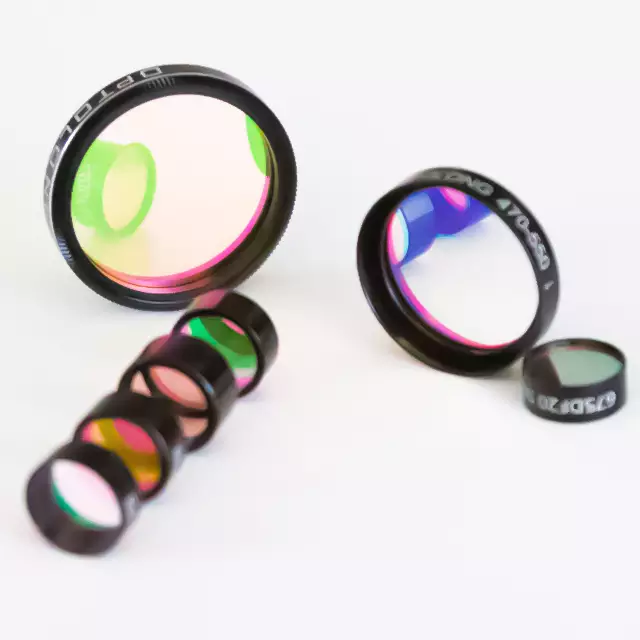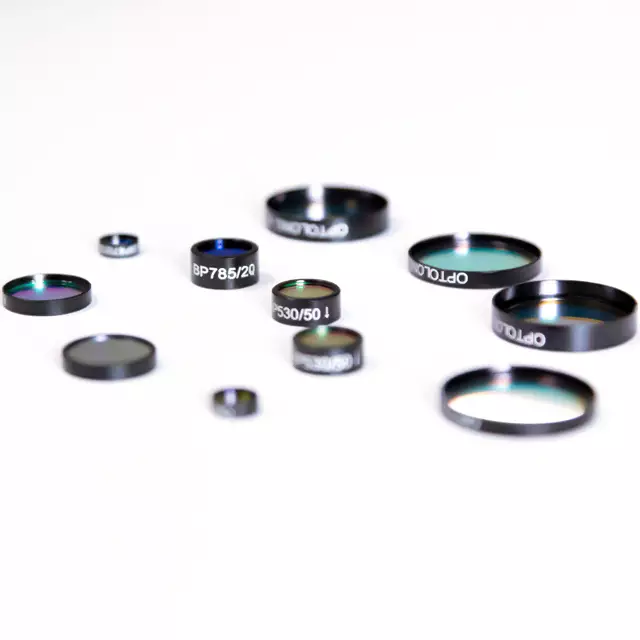Bandpass optical filters are essential components in various optical systems. It enables light transmission within a specific wavelength range while blocking others. In this article, we explained the bandpass filters. These filters play a crucial role in applications ranging from spectroscopy to machine vision. Understanding their functions and applications is paramount for optimizing optical systems.
Bandpass optical filters are devices designed to send a select range of wavelengths of light while blocking others. They consist of materials with specific properties that allow them to transmit light within a range.
What is a Bandpass Filter?

An optical bandpass filter is used in optics that sends a specific range of wavelengths of light while blocking others. It acts as a gatekeeper for light. It allows only a typical “band” or range of wavelengths to pass through while blocking all other wavelengths outside of this range.
This selective transmission makes bandpass filters useful in various applications. Such as spectroscopy, fluorescence microscopy, and telecommunications. Where isolating specific wavelengths of light is necessary.
Construction of Bandpass Filters
Bandpass optical filters are constructed using a variety of techniques. However, the most common method involves thin-film deposition. This process involves layering materials with alternating refractive indices onto a substrate.
Substrate selection
The first step is to choose a suitable substrate material. Depending on the desired filter properties and application, common choices include glass, quartz, or plastic.
Thin-film deposition
We put different materials on a surface, like stacking pancakes. We use methods like sputtering or evaporation. These layers have different abilities to bend light. This decides how the filter works.
Cavity formation
The layers of materials make a space in the filter that’s like its engine. We carefully choose how thick and how many layers to use. This helps us control what colors of light the filter lets through and how wide the range of colors is.
Blocking filter addition
Sometimes, we add another filter to stop colors we don’t want. It can be a thin layer or a different part altogether. This helps make sure only the right colors get through.
Types of Bandpass Filters

Bandpass optical filters can be categorized into different types based on their design and functionalities:
1. Single-cavity filters
These filters are basic. They’re made of a few layers that switch between two types of materials. They only let through a small range of colors and are suitable for jobs where blocking lots of colors is optional.
2. Multi-cavity filters
These filters have many layers, like stacked boxes, each made of different materials. Stacking these layers can block even more colors than simple filters. They’re great for jobs that need particular colors of light.
3. Interference filters
These filters use a neat trick called thin-film interference to work. They can change how thick each layer is and what it’s made of, Let through only specific colors of light or block them. They’re good at picking out the colors you want and are used in things like fancy microscopes and studying light.
4. Dichroic filters
These dichroic filters, also called color filters, do something extraordinary. They bounce back specific colors of light while letting others pass through. They’re handy for splitting light into different colors, like when you need to separate light into two groups based on their colors.
5. Edge filters
These filters let through light either above or below a specific color. People often use them with other filters to get the exact mix of colors they want. For example, a short-pass filter only lets through colors shorter than a certain one. While a long-pass filter only allows through colors that are longer than a certain one.
How do bandpass filters work
Optical bandpass filters are unique because they let specific light colors through while blocking the rest. Here’s how they do it:
1. Picking Favorite
These filters are made of unique layers that like specific light colors more than others.
2. Absorb or Reflect
Some layers soak up colors we don’t want, turning them into heat, while others bounce them away.
3. Staying Specific
They’re designed to only let through a narrow range of colors, called the “passband.” This range can be super precise or broader.
4. Bye-Bye Unwanted Light
Colors outside the passband get stopped or weakened. This is handy for photography and science experiments where we need specific colors.
5. Picture Perfect
In photography, these filters make colors pop or control how light affects a scene. Like making the reds stand out more in a sunset picture.
6. Science Stuff
Scientists use them to study specific light colors in experiments with microscopes. It helps them get accurate results. They’re used in many fields, like astronomy, satellites, and telecom.
Applications of bandpass filters
Bandpass filters have a wide range of applications across various fields due to their ability to allow specific frequencies to pass through while attenuating others.
1. Spectroscopy
In spectroscopy, scientists look at how light interacts with stuff by checking out the colors of light that get soaked up or spit out by a sample. Bandpass filters are super important here.
They work like special glasses, blocking out most colors but letting through the ones we want to see. This helps us determine what chemicals are hanging out in the sample and how much there is.
2. Fluorescence microscopy
This method uses particular molecules that absorb light of one color and give light of a different, longer color. Bandpass filters help these molecules start glowing by giving them the exact right color of light. Then, these filters catch only the glow they make, helping us look at and learn about specific parts or things inside cells or tissues.
3. Telecommunications
Using light and bandpass filters does an excellent job in optical communication systems. They help combine many messages on one light path, like packing other colored candies into a single box. Then, when the messages arrive, these filters sort them out into their colors, like sorting out candies by their colors, making it easy to get lots of messages.
4. Machine vision
Bandpass filters help cameras in machines see better. They make the picture more apparent by blocking out colors we don’t need so the camera can focus on the important stuff. This helps the machine recognize things accurately and quickly, like finding shapes or checking if things are okay.
5. Environmental monitoring
Bandpass filters are like special glasses for machines that check the environment. They help the machines find and measure lousy stuff in the air, water, or dirt. These filters block out extra light and allow the machine to see only the colors that bad stuff makes. This way, they can find out if there’s any pollution around accurately.
6. Color filtering
Colored filters are like special glasses that change how things look or help us see better. Photographers use them to make photos look different colors, like making a sunset look even more orange. Traffic lights use red, yellow, and green filters to show drivers when to stop, get ready, or go. It’s like using different colored lights to tell a story on the road.
7. UV sterilization
Bandpass filters are like special shields for keeping us safe from germs. They let in a special kind of light called ultraviolet (UV), which kills bacteria and viruses in water or air. But they also block out other UV light that can harm us. So, they help clean things up without hurting us or what we’re trying to protect.
8. Medical diagnostics
Bandpass filters are super important in medicine. They help doctors see things better in pictures of our bodies. By picking out specific signals and making the pictures more precise, these filters help doctors find problems and figure out how to fix them. So, they’re like special helpers for making sure we stay healthy.
Conclusion
Bandpass optical filters are like bouncers for light—they only let specific wavelengths through and block the rest. They use layers to absorb some wavelengths and let others pass based on interference. These filters are helpful in many fields, like science, tech, and everyday stuff.
They help with things like checking out tiny stuff with microscopes. Make sure signals in phones and the internet work right, and even keep things clean with UV light. So, they’re key players in all sorts of cool stuff we use daily.
Visit the Optolong website to learn more about related products and choose the filter that best suits your industry.
FAQ
What does a bandpass filter do to an image?
When we process a picture with a bandpass filter, it’s like telling the picture, “Only specific details will stay.” This filter reduces the noise in the picture and helps us to get rid of those distractions due to uneven lighting, making it easier to spot specific features in the picture, such as small dots and edges.
